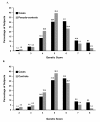Assessing the impact of a combined analysis of four common low-risk genetic variants on autism risk
- PMID: 20678243
- PMCID: PMC2907567
- DOI: 10.1186/2040-2392-1-4
Assessing the impact of a combined analysis of four common low-risk genetic variants on autism risk
Abstract
Background: Autism is a complex disorder characterized by deficits involving communication, social interaction, and repetitive and restrictive patterns of behavior. Twin studies have shown that autism is strongly heritable, suggesting a strong genetic component. In other disease states with a complex etiology, such as type 2 diabetes, cancer and cardiovascular disease, combined analysis of multiple genetic variants in a genetic score has helped to identify individuals at high risk of disease. Genetic scores are designed to test for association of genetic markers with disease.
Method: The accumulation of multiple risk alleles markedly increases the risk of being affected, and compared with studying polymorphisms individually, it improves the identification of subgroups of individuals at greater risk. In the present study, we show that this approach can be applied to autism by specifically looking at a high-risk population of children who have siblings with autism. A two-sample study design and the generation of a genetic score using multiple independent genes were used to assess the risk of autism in a high-risk population.
Results: In both samples, odds ratios (ORs) increased significantly as a function of the number of risk alleles, with a genetic score of 8 being associated with an OR of 5.54 (95% confidence interval [CI] 2.45 to 12.49). The sensitivities and specificities for each genetic score were similar in both analyses, and the resultant area under the receiver operating characteristic curves were identical (0.59).
Conclusions: These results suggest that the accumulation of multiple risk alleles in a genetic score is a useful strategy for assessing the risk of autism in siblings of affected individuals, and may be better than studying single polymorphisms for identifying subgroups of individuals with significantly greater risk.
Figures


Similar articles
-
The genetics of autism.Pediatrics. 2004 May;113(5):e472-86. doi: 10.1542/peds.113.5.e472. Pediatrics. 2004. PMID: 15121991 Review.
-
Autism risk assessment in siblings of affected children using sex-specific genetic scores.Mol Autism. 2011 Oct 21;2(1):17. doi: 10.1186/2040-2392-2-17. Mol Autism. 2011. PMID: 22017886 Free PMC article.
-
Association study in siblings and case-controls of serotonin- and oxytocin-related genes with high functioning autism.J Mol Psychiatry. 2014 Jan 24;2(1):1. doi: 10.1186/2049-9256-2-1. eCollection 2014. J Mol Psychiatry. 2014. PMID: 25408912 Free PMC article.
-
Association Between Mitochondrial DNA Haplogroup Variation and Autism Spectrum Disorders.JAMA Psychiatry. 2017 Nov 1;74(11):1161-1168. doi: 10.1001/jamapsychiatry.2017.2604. JAMA Psychiatry. 2017. PMID: 28832883 Free PMC article.
-
Autism as a paradigmatic complex genetic disorder.Annu Rev Genomics Hum Genet. 2004;5:379-405. doi: 10.1146/annurev.genom.5.061903.180050. Annu Rev Genomics Hum Genet. 2004. PMID: 15485354 Review.
Cited by
-
Does epilepsy in multiplex autism pedigrees define a different subgroup in terms of clinical characteristics and genetic risk?Mol Autism. 2013 Dec 1;4(1):47. doi: 10.1186/2040-2392-4-47. Mol Autism. 2013. PMID: 24289166 Free PMC article.
-
Risk factors for autism: translating genomic discoveries into diagnostics.Hum Genet. 2011 Jul;130(1):123-48. doi: 10.1007/s00439-011-1037-2. Epub 2011 Jun 24. Hum Genet. 2011. PMID: 21701786 Review.
-
Power and predictive accuracy of polygenic risk scores.PLoS Genet. 2013 Mar;9(3):e1003348. doi: 10.1371/journal.pgen.1003348. Epub 2013 Mar 21. PLoS Genet. 2013. PMID: 23555274 Free PMC article.
-
Mitochondrial Aspartate/Glutamate Carrier SLC25A12 and Autism Spectrum Disorder: a Meta-Analysis.Mol Neurobiol. 2016 Apr;53(3):1579-1588. doi: 10.1007/s12035-015-9116-3. Epub 2015 Feb 10. Mol Neurobiol. 2016. PMID: 25663199
-
Complex epigenetic regulation of engrailed-2 (EN-2) homeobox gene in the autism cerebellum.Transl Psychiatry. 2013 Feb 19;3(2):e232. doi: 10.1038/tp.2013.8. Transl Psychiatry. 2013. PMID: 23423141 Free PMC article.
References
-
- Durand CM, Betancur C, Boeckers TM, Bockmann J, Chaste P, Fauchereau F, Nygren G, Rastam M, Gillberg IC, Anckarsater H, Sponheim E, Goubran-Botros H, Delorme R, Chabane N, Mouren-Simeoni MC, de Mas P, Bieth E, Rogé B, Héron D, Burglen L, Gillberg C, Leboyer M, Bourgeron T. Mutations in the gene encoding the synaptic scaffolding protein SHANK3 are associated with autism spectrum disorders. Nat Genet. 2007;39:25–27. doi: 10.1038/ng1933. - DOI - PMC - PubMed
LinkOut - more resources
Full Text Sources
Other Literature Sources

